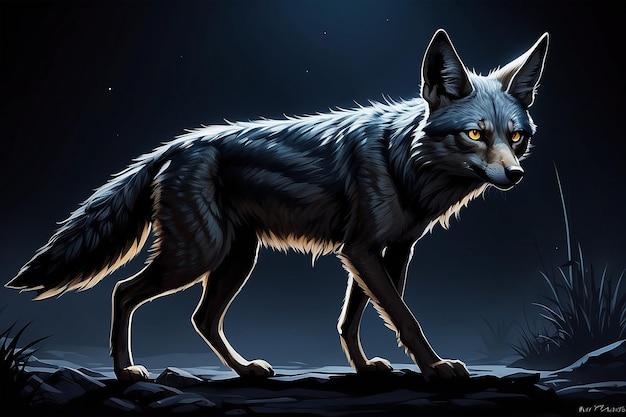Night Hunter: Tracking The Nocturnal Predator

Table of Contents
Understanding Nocturnal Predator Behavior
Tracking any animal effectively requires understanding its behavior. Nocturnal predators, active primarily at night, possess unique adaptations and hunting strategies.
Sensory Adaptations
Nocturnal vision, auditory perception, and olfactory senses are crucial for survival.
- Exceptional Hearing: Owls, for example, possess incredibly sensitive hearing, enabling them to locate prey even in dense foliage. Their asymmetrical ear placement helps pinpoint the precise location of a scurrying mouse.
- Superior Night Vision: Cats, with their tapetum lucidum (a reflective layer behind the retina), have significantly enhanced night vision. Their sensitive whiskers act as highly efficient tactile sensors, mapping their surroundings in low-light conditions.
- Keen Sense of Smell: Many canids, such as coyotes, rely heavily on their olfactory senses to track prey and navigate their territory at night. They can detect scents carried on the night breeze over considerable distances. Understanding these predator adaptations is key to successful tracking.
Hunting Strategies
Nocturnal predators employ a variety of hunting techniques:
- Ambush Predation: Many ambush predators, like owls or large cats, patiently wait for unsuspecting prey to come within striking distance. Identifying potential ambush sites is a crucial aspect of night hunting strategies.
- Stalking: Other predators, such as coyotes, utilize stalking techniques, silently approaching their prey before launching a swift attack. Recognizing stalking signs, like disturbed vegetation, is vital.
- Pursuit Hunting: Some nocturnal hunters, especially those hunting smaller, faster prey, rely on pursuit hunting. Identifying tracks and scat becomes critical in this scenario. Analyzing hunting techniques used by different species is paramount to understanding their movements.
Activity Patterns
The activity patterns of nocturnal predators vary depending on several factors:
- Peak Activity Times: While generally active at night, peak activity often correlates with prey availability and environmental conditions. Some species are most active just after sunset or before sunrise.
- Moon Phase Effect: The brightness of the moon significantly impacts the activity of some nocturnal predators. A full moon might make them less active due to increased visibility to both prey and predators.
- Influence of Prey Availability: The abundance of prey is a primary driver of nocturnal predator activity. Areas with abundant prey will show higher levels of activity. Understanding these activity cycles helps predict where and when to look for signs.
Essential Tools and Techniques for Night Hunter Tracking
Successful night tracking requires specialized equipment and skills.
Equipment for Night Tracking
Investing in the right night vision equipment can drastically improve your tracking success:
- Night Vision Goggles or Scopes: These amplify available light, allowing you to observe animals in near darkness.
- Thermal Imaging Devices: These detect heat signatures, making it possible to locate animals even in complete darkness.
- Headlamps (Red Light): Red light preserves your night vision better than white light.
- GPS Trackers: These are crucial for navigation and marking locations of interest.
- Cameras with Low-Light Capabilities: These allow you to capture photographic evidence of your observations.
Reading Nocturnal Signs
Learning to interpret nocturnal animal signs is crucial:
- Tracks: Analyzing tracks provides clues about the animal's size, species, gait, and direction of travel.
- Scat: Scat analysis can reveal dietary habits and species identification.
- Scratch Marks: These may indicate where an animal has been sharpening its claws or marking its territory.
- Broken Branches: These can indicate the passage of a larger animal through an area.
- Kill Sites: These offer invaluable insights into hunting behavior and prey selection.
Safety Precautions for Night Tracking
Safety should always be your top priority:
- Partner Up: Always go with a trusted companion.
- Appropriate Gear: Carry appropriate safety gear, including a first-aid kit, a map and compass, and a communication device.
- Environmental Awareness: Be aware of your surroundings and potential hazards.
- Respect for Wildlife: Maintain a safe distance from animals and never approach or harass them. Prioritize wildlife safety above all else.
Case Studies: Tracking Specific Night Hunters
Let's examine specific examples:
- Bobcat Tracking: Bobcats leave distinctive tracks and often use established trails. Knowing their preferred habitats and prey (rabbits, rodents) aids in bobcat tracking.
- Owl Tracking: Owl pellets (regurgitated indigestible remains) are a valuable sign, indicating roosting locations. Listening for their calls can also help locate them.
- Coyote Tracking: Coyotes often travel in packs, leaving multiple tracks. Their scat is usually easily identifiable and can indicate their diet. Mastering coyote tracking requires patience and a keen eye. Each case study highlights unique challenges and techniques.
Conclusion: Mastering the Art of the Night Hunter
Becoming a skilled Night Hunter demands patience, knowledge, and respect for wildlife. Understanding nocturnal predator behavior, employing the right equipment, and interpreting signs correctly are crucial elements. Remember, responsible observation and safety are paramount. Become a skilled Night Hunter by researching specific nocturnal predators in your area and practicing responsible tracking techniques. Further your knowledge by exploring resources such as wildlife tracking guides and reputable online resources dedicated to wildlife observation. Remember that responsible night hunter practices are essential for protecting both the animals and yourself.

Featured Posts
-
 Zahabi Vs Aldo A L Ufc 315 Montreal Predictions Et Analyse
May 12, 2025
Zahabi Vs Aldo A L Ufc 315 Montreal Predictions Et Analyse
May 12, 2025 -
 Lily Collins And Charlie Mc Dowells Daughter Tove Family Photos
May 12, 2025
Lily Collins And Charlie Mc Dowells Daughter Tove Family Photos
May 12, 2025 -
 Lowrys Strong Showing Contention At The Valspar Championship
May 12, 2025
Lowrys Strong Showing Contention At The Valspar Championship
May 12, 2025 -
 Crazy Rich Asians Tv Adaptation Officially In The Works At Max
May 12, 2025
Crazy Rich Asians Tv Adaptation Officially In The Works At Max
May 12, 2025 -
 Eric Antoine Et Sa Compagne Apparition Remarquee A La Premiere Parisienne
May 12, 2025
Eric Antoine Et Sa Compagne Apparition Remarquee A La Premiere Parisienne
May 12, 2025
Latest Posts
-
 Ray Epps Defamation Lawsuit Against Fox News Details Of The January 6th Allegations
May 12, 2025
Ray Epps Defamation Lawsuit Against Fox News Details Of The January 6th Allegations
May 12, 2025 -
 Cocaine At The White House Secret Service Wraps Up Investigation
May 12, 2025
Cocaine At The White House Secret Service Wraps Up Investigation
May 12, 2025 -
 White House Cocaine Found Secret Service Concludes Inquiry
May 12, 2025
White House Cocaine Found Secret Service Concludes Inquiry
May 12, 2025 -
 The Most Emotional Rocky Movie According To Sylvester Stallone
May 12, 2025
The Most Emotional Rocky Movie According To Sylvester Stallone
May 12, 2025 -
 Which Rocky Movie Touches Sylvester Stallone The Most
May 12, 2025
Which Rocky Movie Touches Sylvester Stallone The Most
May 12, 2025
